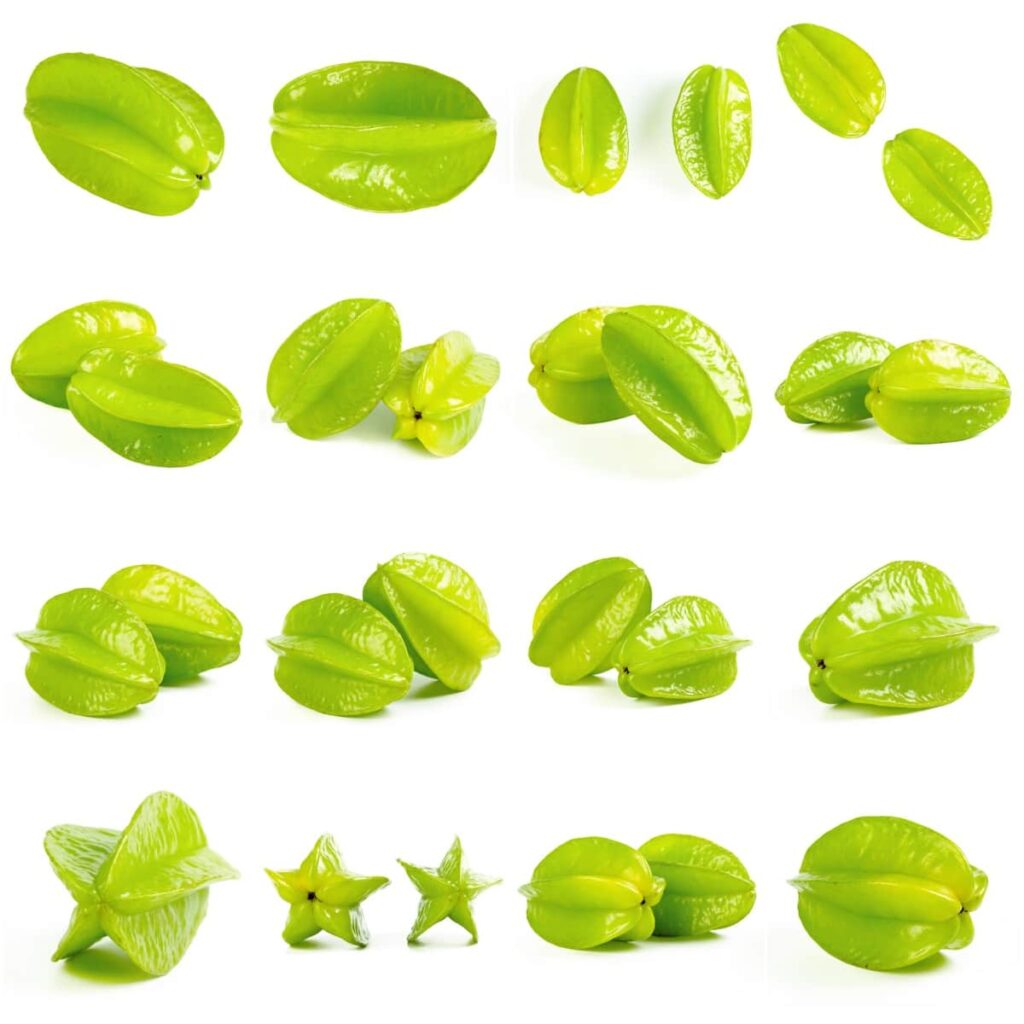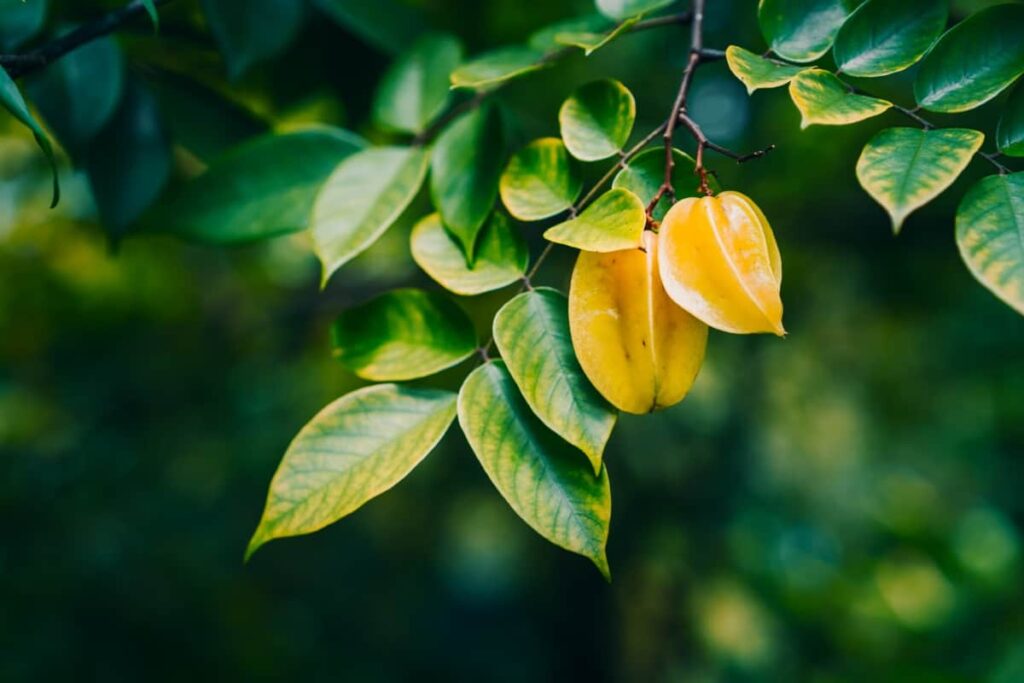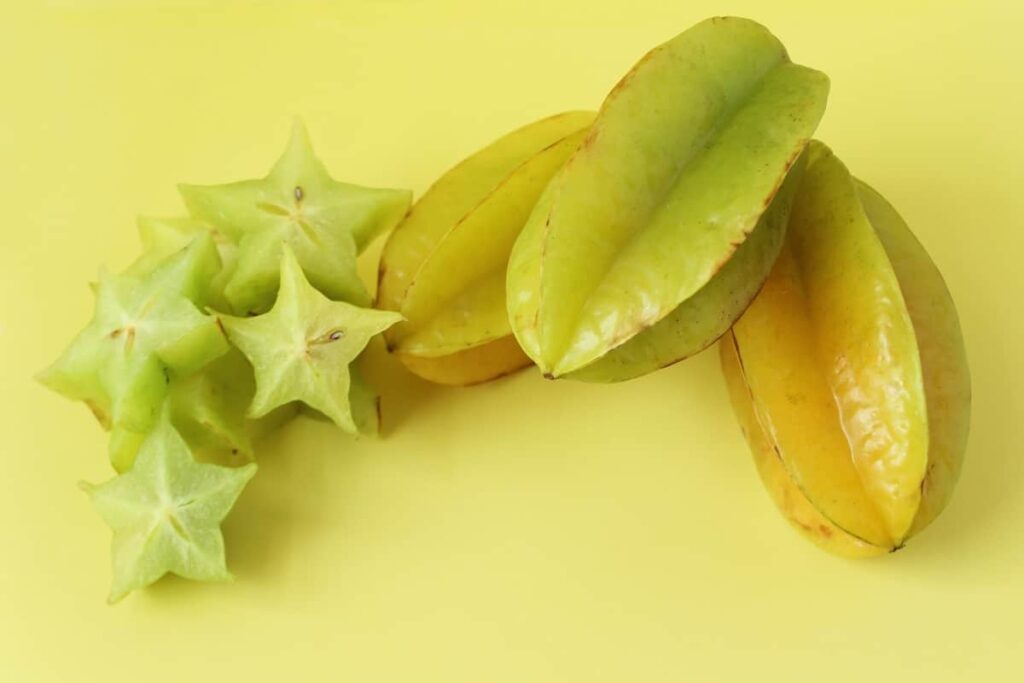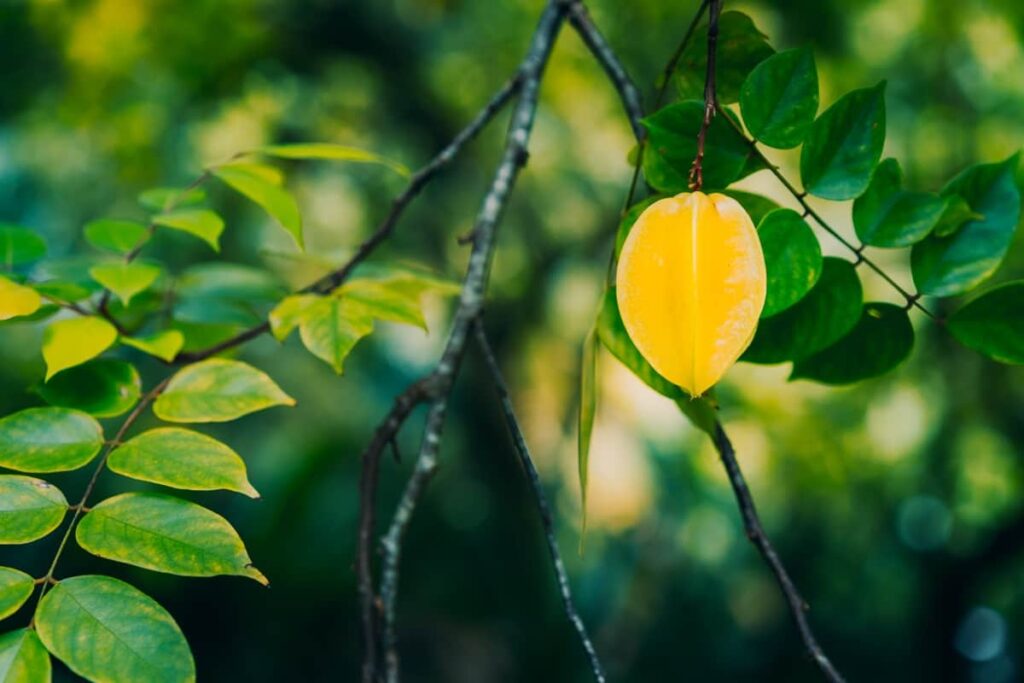Discover the ultimate roadmap for managing Carambola Orchards throughout the year with our comprehensive guide. With accurate data and simplified explanations, this blog provides step-by-step instructions for optimizing your orchard’s operations and maintenance practices.

From pruning and fertilization to pest control and irrigation, each month’s tasks are summarized and rewritten with a high degree of perplexity and burstiness, making it easy to grasp and implement. Our guide ensures you stay on track, maximizing productivity and yield. Whether you’re a seasoned orchardist or just starting, this resource equips you with the knowledge to nurture thriving Carambola Orchards all year.
Carambola/Star Fruit Orchard Management
What is Carambola/Star Fruit Farming and its Overview?
Carambolas, also known as star fruit, have the scientific name Averrhoa carambola L. and belong to the Oxalidaceae family. Originating from Southeast Asia, these fruits are cultivated in various tropical and warm subtropical regions across the globe. Commercial production of carambolas occurs in southern Florida and Hawaii within the United States, primarily in Dade, Lee, Broward, and Palm Beach counties. The cultivation of carambolas has a rich history, with centuries of cultivation in Southeast Asian countries such as Malaysia, India, and Sri Lanka.
Over 100 years ago, carambola trees were introduced to Florida, initially yielding tart fruit. However, sweet cultivars were later selected by introducing seeds and vegetative material from Thailand, Taiwan, and Malaysia. Carambola farming holds significant importance as consumer awareness and demand for star fruit increase. Taiwan, Malaysia, Guyana, India, Philippines, Australia, Israel, and the United States (Florida and Hawaii) are major producers of carambola globally.
Description of Carambola/Star Fruit
- The carambola tree is small to medium in height, evergreen, and can reach a diameter of 20 to 25 feet. The primary fruit-producing area of mature trees is in the mid-canopy region. The compound leaves of carambolas are arranged alternately on branches, each consisting of 5 to 11 green leaflets.
- Carambola flowers have pink to lavender coloration and are on panicles on twigs and small branches. The perfect flowers have five petals and sepals, varying styles depending on the cultivar.
- The carambola fruit is a fleshy 4- to 5-celled berry with a waxy surface. It measures 2 to 6 inches long and has five prominent longitudinal ribs, giving it a star-shaped cross-section. The fruit skin is thin, light to dark yellow, and smooth. The fruit’s flesh is translucent, juicy, and without fiber, with a subacid to sweet flavor in good cultivars.
- It is best to allow the fruit to ripen on the tree for optimal sweetness. Carambola fruit is low in calories, rich in potassium, and a moderate source of vitamin C.
- Seeds in carambola fruit are edible but usually limited to around 10-12 per fruit, or sometimes none. A gelatinous aril encloses the seeds, is thin and light brown, and loses viability shortly after the fruit removal.
In case you missed it: Optimizing Jackfruit Orchard Management: A Month-by-Month Operation Guide for Maximum Yield

Best Tips for Growing Carambola/Star Fruit
Cultivars
Numerous cultivars are available for carambola, although some may be difficult to find due to limited plant-propagation material. Carambolas can be classified into two main types: sweet and tart. Sweet types are recommended for consuming fresh, while sweet and tart types are suitable for processing and home recipes. Some tart cultivars, such as ‘Golden Star,’ acquire a sweet flavor if allowed to ripen on the tree and turn golden yellow.
Pollination
Carambola flowers exhibit heterostyly, where each cultivar has either long or short styles. Some cultivars may require cross-pollination between different stylar types (short-styled and long-styled) for optimal fruit sets and yields. However, certain cultivars like ‘Golden Star’ and ‘Arkin’ produce abundant crops even when planted in solid blocks, suggesting that cross-pollination may only sometimes be necessary.
Climate
Carambola thrives best in tropical lowland climates but can grow well in warm subtropical regions that experience occasional freezing temperatures. In Florida, suitable locations for carambola cultivation include warm areas along the southeastern and southwestern coasts (e.g., Merritt Island and Tampa Bay area) and various counties like Dade, Lee, Broward, Palm Beach, Monroe, and Collier.
Cold temperatures between 20°F and 32°F (-6.7°C to 0°C) can cause damage to leaves, twigs, and trees, depending on their maturity. Wind protection is crucial, and cultivars like ‘Golden Star’ and ‘Newcomb’ exhibit better tolerance to windy conditions.
Propagation Practices
Carambola cultivars are typically grafted onto seedling rootstocks. For instance, ‘Golden Star seedlings are better suited to the limestone soils in south Dade County compared to ‘Arkin’ rootstocks. Successful grafting techniques include veneer grafting and chip budding during active growth periods.
It is recommended to use healthy seedlings with a diameter of around ¼ inch (7 mm) as rootstocks. Graftwood should be taken from mature twigs with leaves, preferably when buds are just beginning to grow. Top-working of older trees can be done through bark and veneer grafting while air-layering and tissue culture have shown limited success due to poor root development.
Production and Harvesting Practices
Carambola trees grown in wind-protected areas can start producing fruit within 10 to 14 months after planting. During the initial years, each tree can yield between 10 to 40 lbs (4.5 to 18 kg) of fruit annually, with production increasing significantly as the trees mature. By years 5 and 6, each tree can produce around 100 to 150 lbs (45 to 68 kg) of fruit, and mature trees (7 to 12 years old) may yield 250 to 350 lbs (112 to 160 kg) or more per year.
Carambola has two major bloom seasons in South Florida, from April to May and September to October, with some blooming throughout the year. The harvest season typically spans from June to February, with peak production from August to October and December to February. Commercially, fruit is hand-picked when a yellow color begins to develop in the furrow between the ribs while the tips of the ribs remain green. For home use, fruit can be left on the tree until fully ripe (yellow to golden yellow).
In case you missed it: Optimizing Tamarind Orchard Management: A Month-by-Month Maintenance Guide for High Yields and Profit

Spacing, Pruning, and Irrigation Practices
Commercial carambola plantings in South Florida utilize various spacings, with most having 118 to 145 trees. Per acre (290 to 358 trees per hectare). The recommended spacing for carambola trees is typically 20 to 25 feet between rows and 10 to 15 feet (3 to 4.6 meters) between trees within a row. Pruning plays a crucial role in maintaining the health and productivity of carambola trees.
It helps promote proper airflow, light penetration, and fruit quality. Pruning should be done annually during the dry season when the trees are not actively growing. The main objectives of pruning include removing dead or diseased branches, thinning out crowded areas, and shaping the tree to maintain an open canopy structure. Pruning can also help manage tree height, especially in areas prone to wind damage. Irrigation is essential for carambola trees, particularly during dry periods and fruit development stages.
Proper irrigation practices ensure optimal tree growth and fruit production. Young trees require frequent irrigation until established, while mature trees benefit from deep, infrequent watering to encourage deep root development. Drip irrigation systems are commonly used in carambola orchards to provide efficient water distribution and minimize water loss through evaporation. Monitoring soil moisture levels and adjusting irrigation schedules to prevent over or under-watering is important.
Fertilization
Carambola trees have specific nutritional requirements for optimal growth and fruit production. A soil test is recommended to determine the soil’s nutrient status and pH level. Based on the test results, a balanced fertilizer program can be implemented. Generally, nitrogen (N), phosphorus (P), and potassium (K) are the primary nutrients needed.
However, carambola trees also require secondary macronutrients (calcium, magnesium, and sulfur) and micronutrients (iron, manganese, zinc, copper, molybdenum, and boron) for healthy growth. Fertilizers should be applied in split doses throughout the year, with most of the application during the active growing season.
Pest and Disease Management
Carambola trees can be susceptible to various pests and diseases, affecting tree health and fruit quality. Common pests include fruit flies, aphids, scales, mites, and caterpillars. Regularly monitoring trees and prompt action at the first sign of pest infestation is crucial. Integrated Pest Management (IPM) practices should be employed, including cultural controls, biological controls, and, if necessary, targeted pesticide applications.
It is important to follow the instructions and recommendations provided by local agricultural extension services or experts. Disease management involves preventive measures such as selecting disease-resistant cultivars, practicing good sanitation, and providing proper tree care. Some common diseases of carambola include anthracnose, root rot, and fungal infections. Regular inspections, proper pruning to improve airflow, and removing and disposing of infected plant material can help minimize the disease risk.
In case you missed it: Optimizing Indian Gooseberry/Amla Orchard Management: A Month-by-Month Operation Guide for Maximum Yield

January Month Carambola/Star Fruit Orchard Maintenance Planning
- Apply NPK (nitrogen-phosphate-potash) fertilizer to provide essential nutrients for tree growth and fruit production.
- Monitor trees for scales, other insects, and signs of root rot.
- This delay in fruit production is because cool temperatures during the fall and winter may prevent fruit sets from January to March.
February Month Carambola/Star Fruit Orchard Maintenance Planning
- Continue applying NPK fertilizer for tree nutrition.
- Monitor for stink bugs, particularly when the fruit is present.
- Prune trees to control their size and maintain a desired shape.
March Month Carambola/Star Fruit Orchard Maintenance Planning
- Apply NPK fertilizer to support tree growth and fruit development.
- Monitor for signs of root rot, especially in trees exposed to excessive moisture or flooding.
April Month Carambola/Star Fruit Orchard Maintenance Planning
- Continue with NPK fertilizer applications to ensure optimal tree health and fruit production.
- Monitor for scales and other insect pests.
- Pruning can be done to manage tree size and shape.
May Month Carambola/Star Fruit Orchard Maintenance Planning
- Apply NPK fertilizer to meet the nutrient requirements of carambola trees.
- Monitor for root rot and take necessary measures if observed.
- Water trees during dry periods, typically 1 to 2 times per week.
June Month Carambola/Star Fruit Orchard Maintenance Planning
- Apply NPK fertilizer to support tree growth and fruit production.
- Prune or bend and clip whips to encourage off-season fruit production in October.
- Watering frequency may be adjusted during the cooler winter months.
July Month Carambola/Star Fruit Orchard Maintenance Planning
- Continue applying NPK fertilizer for tree nutrition.
- Monitor for insect pests, particularly scales.
- Prune trees as needed to maintain their desired size and shape.
August Month Carambola/Star Fruit Orchard Maintenance Planning
- Apply NPK fertilizer to provide essential nutrients for tree growth and fruit development.
- Monitor for signs of root rot and take appropriate action.
- Prune trees to manage their size and promote proper airflow.
- Pruning during August may result in fruit during October.
In case you missed it: Optimizing Cocoa Orchard Management: A Month-by-Month Garden Maintenance Guide for High Yields and Profit

September Month Carambola/Star Fruit Orchard Maintenance Planning
- Continue with NPK fertilizer applications to support tree health and fruit production.
- Monitor for insect pests, such as stink bugs.
- Pruning can be done to control tree size and shape.
October Month Carambola/Star Fruit Orchard Maintenance Planning
- Apply NPK fertilizer to meet the nutritional needs of carambola trees.
- Prune or bend and clip whips to encourage fruit production in June.
- Monitor for root rot and take necessary measures if detected.
November Month Carambola/Star Fruit Orchard Maintenance Planning
- Continue applying NPK fertilizer for tree nutrition.
- Monitor for scales and other insect pests.
- Prune trees as needed to maintain their desired shape and size.
- Pruning during November–December may result in fruit during February–April or June.
December Month Carambola/Star Fruit Orchard Maintenance Planning
- Apply NPK fertilizer to support tree growth and fruit development.
- Monitor for signs of root rot, particularly in trees exposed to wet conditions.
- Pruning can be done to manage tree size and enhance early fruit production.
- Remove young fruit from trees in November–December to conserve carambola leaves and encourage early spring flowering and June fruit.
- Young fruit removal and strategic pruning may encourage blooming and off-season fruit output.
Fertilizer Recommendations For Carambola Trees
In the first year, apply fertilizer 5-6 times with a rate of 0.25-0.5 lbs per application. Additionally, spray minor elements 4-6 times a year and use 0.5-0.75 oz of iron chelate drenches per tree annually. Continuing to the second and third years, maintain the same frequency of fertilizer applications, increasing the rate to 0.5-1.5 lbs per application. Spray minor elements and use 0.75-1.5 oz of iron chelate drenches per tree each year.
In case you missed it: Almond Orchard Management: Month-by-Month Maintenance Guide for Maximum Yield

From the fourth to the eighth year, adjust the fertilizer application to 4-6 times per year, with rates ranging from 1.5-4.5 lbs per application. The frequency of spraying minor elements should be 4-6 times annually, and iron chelate drenches should be applied at a rate of 1.5-4 oz per tree per year.
Conclusion
The Orchard Calendar provides a comprehensive and practical guide for successful year-round operations and Carambola/Star Fruit Orchards maintenance. With detailed instructions and recommendations, it ensures optimal care and productivity, leading to a thriving and profitable orchard.
- Crops Grown in Summer Season: Best Choices for Summer Gardening
- Organic Pest Control for Tomato Farming
- How to Maximize Sheep Farming Profit
- Broccoli Varieties: Choosing the Right Cultivars for Your Farm
- How to Raise Pigs in Your Own Backyard: A Comprehensive Guide
- Budget Friendly Sheep Shed Ideas: Cheap and Low-Cost Tips
- How Much Do Cattle Farmers Make: Revenue Streams in Cattle Farming
- Management Pests and Diseases in Your Cotton Field
- Sheep Farming Business Plan for Beginners
- Aquaponic Farming at Home: A Step-By-Step Guide
- Profitable Village Farming Business Ideas in 2024
- High-Yield Aquaculture: Fast-Growing Fish for Farming
- Effective Fish Pond Construction Techniques for Beginners
- Irrigation and Water Management in Pineapple Farming
- Blossom to Harvest: Mastering Flowering and Pollination in Papaya Farming
- Pig Fattening Essentials: From Selection to Sale for Beginners
- Raising Wagyu Cattle: A Complete Guide for Premium Beef Production
- Soil Types and Their Water Holding Capacity
- Optimizing Irrigation Schedules for Coconut Groves for Enhanced Yield
- Espresso Your Garden: Coffee Grounds for Healthier Acid-Loving Plants
- The Best Soil Mix for Snake Plants: How to Mix Your Own Snake Plant Soil
- Green Thumb Success: Expert Tips for Cultivating Greenhouse Beans All Year Round
- Bloom All Year Round: The Ultimate Guide to Indoor Hyacinth Care
- Eco-Friendly Gardening: How to Make Liquid Fertilizer from Kitchen Waste
- Ultimate Guide to Grow Anise in Pots: Explore Seed Propagation to Harvesting
- Guide to Raising Chester White Pigs: Discover Breed Facts to Growth Management
- Mastering the Elegance: The Ultimate Guide to Weeping Cherry Tree Care, Planting, and Maintenance
- Ultimate Guide to Planting Garlic in Grow Bags: Growing Strategies for Beginners
- How to Fix Spider Plant Leaf-Related Problems: Natural and Organic Remedies
- 10 Reasons Why Your Tulsi Plant is Shedding Leaves: Home Remedies and Solutions
- Optimizing Growth and Yield: The Advantages of Palm Bunch Ash Fertilizer
- Utilizing Neem Oil Extract as a Natural Pesticide for Hydrangea
- From Soil to Harvest: Various Ways in Which Farmers Can Use AI Tools
- Steps to Encourage and Induce Citrus Flowers: A Comprehensive Guide
- How to Fix Snake Plant Leaf-Related Issues: Natural and Organic Remedies
- Transform Your Garden into a Fragrant Oasis with Raat Ki Rani (Night Blooming Jasmine)
